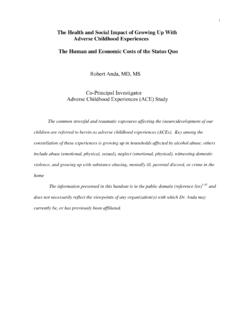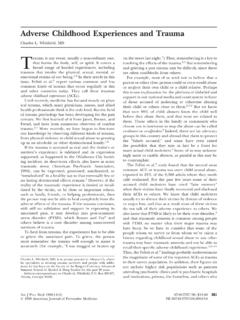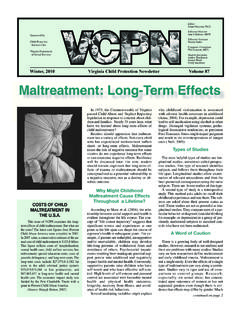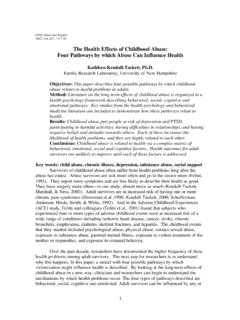Transcription of The interrelatedness of multiple forms of childhood abuse ...
1 Child abuse & neglect 28 (2004) 771 784 The interrelatedness of multiple forms of childhood abuse , neglect , and household dysfunction Maxia Donga, , Robert F. Andaa, Vincent J. Felittib, Shanta R. Dubea,David F. Williamsona, Theodore J. Thompsona, Clifton M. Looa, Wayne H. GilesaaDivision of Adult and Community Health, National Center for Chronic Disease Prevention and Health Promotion, Centersfor Disease Control and Prevention, 4770 Buford Highway, , MS K-67, Atlanta, GA 30341 3717, USAbDepartment of Preventive Medicine, Southern California Permanente Medical Group, San Diego, CA, USAR eceived 17 January 2003; received in revised form 16 January 2004; accepted 23 January 2004 AbstractObjective: childhood abuse and other adverse childhood experiences (ACEs) have historically been studied in-dividually, and relatively little is known about the co-occurrence of these events.
2 The purpose of this study is toexamine the degree to which ACEs co-occur as well as the nature of their :We used data from 8,629 adult members of a health plan who completed a survey about 10 ACEs whichincluded: childhood abuse (emotional, physical, and sexual), neglect (emotional and physical), witnessing domesticviolence, parental marital discord, and living with substance abusing, mentally ill, or criminal household bivariate relationship between each of these 10 ACEs was assessed, and multivariate linear regression modelswere used to describe the interrelatedness of ACEs after adjusting for demographic :Two-thirds of participants reported at least one ACE; 81% 98% of respondents who had experienced oneACE reported at least one additional ACE (median: 87%). The presence of one ACE significantly increased theprevalence of having additional ACEs, elevating the adjusted odds by 2 to times (median: ).
3 The observednumber of respondents with high ACE scores was notably higher than the expected number under the assumptionof independence of ACEs (p<.0001), confirming the statistical interrelatedness of :The study provides strong evidence that ACEs are interrelated rather than occurring , collecting information about exposure to other ACEs is advisable for studies that focus on the The Adverse childhood Experiences Study was supported under a cooperative agreement #TS-44 10/11 from the Centersfor Disease Control and Prevention through the Association of Teachers of Preventive Medicine and is currently funded by agrant from the Garfield Memorial Fund at Kaiser Permanente. Dr. Dong was supported by cooperative agreement #TS-44 10/11from the Centers for Disease Control and Prevention through the Association of Teachers of Preventive Medicine.
4 Corresponding $ see front matter 2004 Elsevier Ltd. All rights Dong et al. / Child abuse & neglect 28 (2004) 771 784consequences of a specific ACE. Assessment of multiple ACEs allows for the potential assessment of a gradedrelationship between these childhood exposures and health and social outcomes. 2004 Elsevier Ltd. All rights :Child abuse ; Child neglect ; household dysfunction ; InterrelationshipIntroductionFor years, the study of the long-term sequelae of childhood maltreatment has focused primarily on singletypes of maltreatment, particularly sexual or physical abuse . The recent literature includes an increasingnumber of studies that assess the impact of more than one type of abuse (Bensley, van Eenwyk, &Simmons, 2000;Briere & Runtz, 1990;Brown, Cohen, Johnson, & Smailes, 2000;De Bellis et al.)
5 , 2001;Johnson, Cohen, Kasen, & Brook, 2002;Lau, Liu, Cheung, Yu, & Wong, 1999;Liebschutz et al., 2002;Mullen, Martin, Anderson, Romans, & Herbison, 1996;Walsh, MacMillan, & Jamieson, 2002). Thesestudies have shown that the long-term effects of childhood maltreatment are not necessarily the result ofany single type of abuse , such as sexual abuse , but may be due to other pathological elements as well,such as psychological abuse , neglect , and family disorganization (Finkelhor, Araji, Baron, Peter, & Wyatt,1986).Although the co-occurrence of multiple forms of childhood abuse and household dysfunction is common(Anda et al., 1999;Dong, Anda, Dube, Giles, & Felitti, 2003;Dube, Anda, Felitti, Croft, et al., 2001;Dube, Williamson, Thompson, Felitti, & Anda, 2004;Felitti et al., 1998; Finkelhor, 1998), no summaryanalysis of the interrelationships among multiple forms of adverse childhood experiences (ACEs) has beenreported.
6 A full exploration of the interrelationships is critical to understanding of long-term effects ofACEs. Researchers who study only one or two of these childhood exposures are likely to miss the apparentnegative effects of co-occurring traumatic or stressful experiences. Moreover, when such co-occurrenceis ignored, researchers and clinicians may hold the implicit assumption that the meaning of the presenceof one type of childhood adversity is the same in all cases whether or not others are present (Caron& Rutter, 1991). In fact, conditions such as substance abuse , domestic violence, and criminal activityin the household frequently co-occur with other forms of childhood abuse . Without assessment of theimpact of these other factors, long-term influence might wrongly be attributed solely to single types ofmaltreatment, and the cumulative influence of multiple categories of ACEs would go un-assessed (Andaet al.)
7 , 1999; Felitti et al., 1998).Previous studies have shown that ACEs can be viewed as a complex set of highly interrelated experiencesthat may include childhood abuse or neglect , parental alcohol and drug abuse , domestic violence, parentalmarital discord, and crime in the home (Anda et al., 1999;Dong, Anda, et al., 2003;Dube, Anda, Felitti,Croft, et al., 2001;Dube, Felitti, Dong, Felitti, Edwards, & Croft, 2002;Dube, Felitti, Dong, Chapman,Giles, & Anda, 2003;Dube et al., 2003; Dube et al., 2004; Felitti et al., 1998). Moreover, strong gradedrelationships between multiple categories of ACEs and many health-related problems have been reported,such as smoking, adult alcohol problems, drug abuse , unintended pregnancies, male involvement in teenpregnancy, sexually transmitted diseases, liver disease, and suicide attempts, as well as the leading causesof death in the United States (Anda et al.
8 , 1999, 2001, 2002; Dietz et al., 1999;Dong, Dube, Giles, Felitti,& Anda, 2003;Dube, Anda, Felitti, Chapman, et al., 2001;Dube, Anda, Felitti, Croft, et al., 2001;Dubeet al., 2003;Felitti et al., 1998;Hillis, Anda, Felitti, Nordenberg, & Marchbanks, 2000).M. Dong et al. / Child abuse & neglect 28 (2004) 771 784773In this study, we analyzed data from the larger ACE Study, a collaboration between Kaiser Permanentein San Diego, California, and the Centers for Disease Control and Prevention (CDC), to provide a detaileddescription of the interrelationships among 10 categories of ACEs. These categories included childhoodabuse (emotional, physical, and sexual), neglect (emotional and physical), and household dysfunction (growing up with domestic violence, parental marital discord, and substance abusing, mentally ill, orcriminal household members).
9 In our analyses, we used the ACE score, which is the sum of the numberof categories of ACEs, as a summary measure of the total number of these childhood exposures. We firstdescribe the bivariate relationships among the ACEs and then use multivariate linear regression modelsto describe the interrelatedness of ACEs after adjusting for demographic factors. Finally, we test the nullhypothesis that the observed distribution of the ACE score varies from the distribution that would beexpected under the assumption that the 10 exposures are data were collected as a portion of the ACE Study, the overall objective of which is to evaluate theassociation of numerous interrelated ACEs to a wide variety of health behaviors and health detailed description of the methods used in the ACE Study has been published elsewhere (Felitti et al.)
10 ,1998). The study was approved by the institutional review boards of Kaiser Permanente and the Officeof Protection from Research Risks at the National Institutes of Health. Potential participants receivedthe ACE Study questionnaire by mail along with a letter, informing them that their participation wasvoluntary and that their responses would be held in the strictest confidence and would never become partof their medical populationThe study population included adult members of the Kaiser Health Plan in region of San Diego,California. The subscribers of Kaiser Plan represent a broad range of the general population. Each yearmore than 50,000 members receive a standardized medical and biopsychosocial examination at Kaiser sHealth Appraisal Center in San Diego. The examination is performed primarily as a comprehensive healthassessment rather than providing symptom- or illness-based care.











